Python实现数据可视化案例分析
1. 问题描述
2. 实验环境
3. 实验步骤及结果
1. 问题描述对右图进行修改:
请更换图形的风格
请将 x 轴的数据改为-10 到 10
请自行构造一个 y 值的函数
将直方图上的数字,位置改到柱形图的内部垂直居中的位置
对成绩数据 data1402.csv 进行分段统计:每 5 分作为一个分数段,展示出每个分数段的人数直方图。
自行创建出 10 个学生的 3 个学期排名数据,并通过直方图进行对比展示。
线图把这个图像做一些调整,要求出现 5 个完整的波峰。
调大 cos 波形的幅度
调大 sin 波形的频率
用线图展示北京空气质量数据
展示 10-15 年 PM 指数月平均数据的变化情况,一幅图中有 6 条曲线,每年 1 条曲线。
2. 实验环境Microsoft Windows 10 版本18363
PyCharm 2020.2.1 (Community Edition)
Python 3.8(Scrapy 2.4.0 + numpy 1.19.4 + pandas 1.1.4 + matplotlib 3.3.3)
3. 实验步骤及结果对右图进行修改:
请更换图形的风格
请将 x 轴的数据改为-10 到 10
请自行构造一个 y 值的函数
将直方图上的数字,位置改到柱形图的内部垂直居中的位置
from matplotlib import pyplot as plt
import numpy as np
fig, ax = plt.subplots()
plt.style.use('classic')
plt.title("square numbers")
ax.set_xlim(-11, 11)
ax.set_ylim(0, 100)
x = np.array(range(-10, 11))
y = x * x
rect1 = plt.bar(x, y)
for r in rect1:
ax.text(r.get_x(), r.get_height() / 2, r.get_height())
plt.show()
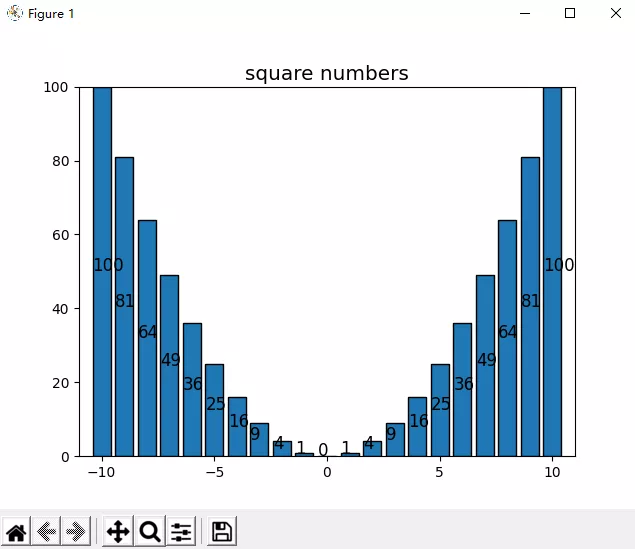
如图使用 classic 风格,x 轴数据为[-10, 10]的整数,构造的函数为 y=x2,显示位置并将其将数值改到了柱形图内部垂直居中的位置。
对成绩数据 data1402.csv 进行分段统计:每 5 分作为一个分数段,展示出每个分数段的人数直方图。
from matplotlib import pyplot as plt
import numpy as np
import pandas as pd
df = pd.read_csv("./data1402.csv", encoding='utf-8', dtype=str)
df = pd.DataFrame(df, columns=['score'], dtype=np.float)
section = np.array(range(0, 105, 5))
result = pd.cut(df['score'], section)
count = pd.value_counts(result, sort=False)
fig, ax = plt.subplots()
plt.style.use('classic')
ax.set_xlim(0, 100)
rect1 = plt.bar(np.arange(2.5, 100, 5), count, width=5)
for r in rect1:
ax.text(r.get_x(), r.get_height(), r.get_height())
plt.show()
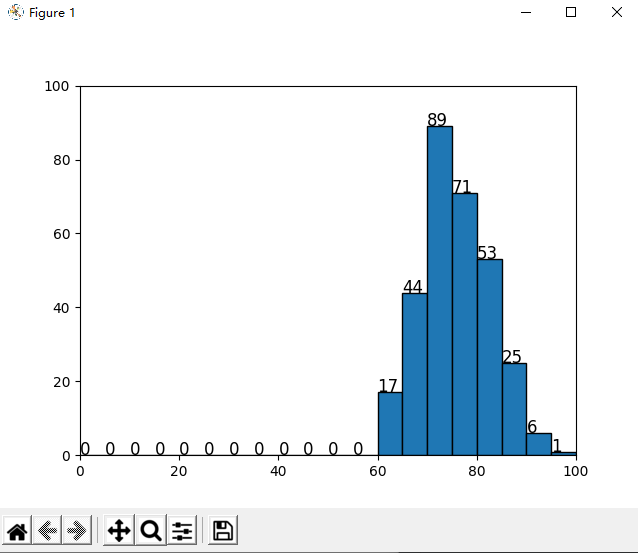
自行创建出 10 个学生的 3 个学期排名数据,并通过直方图进行对比展示。
import random
semester1 = np.arange(1, 11)
semester2 = np.arange(1, 11)
semester3 = np.arange(1, 11)
random.shuffle(semester1)
random.shuffle(semester2)
random.shuffle(semester3)
df = pd.DataFrame({'semester1':semester1, 'semester2':semester2, 'semester3':semester3})
print(df)
df.to_csv("data1403.csv", encoding="utf-8")
使用如上代码创建出随机的排名数据。
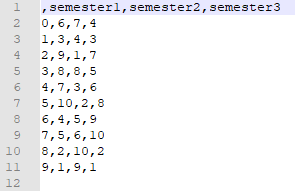
df = pd.read_csv("./data1403.csv", encoding='utf-8', dtype=str)
df = pd.DataFrame(df, columns=['semester1', 'semester2', 'semester3'], dtype=np.int)
df['total'] = (df['semester1'] + df['semester2'] + df['semester3']) / 3
df = df.sort_values('total')
fig, ax = plt.subplots()
plt.style.use('classic')
plt.title('RANK')
width = 0.2
x = np.array(range(0, 10))
rect1 = ax.bar(x-2*width, df['semester1'], width=width, label='semester1')
rect2 = ax.bar(x-width, df['semester2'], width=width, label='semester2')
rect3 = ax.bar(x, df['semester3'], width=width, label='semester3')
for r in rect1:
ax.text(r.get_x(), r.get_height(), r.get_height())
for r in rect2:
ax.text(r.get_x(), r.get_height(), r.get_height())
for r in rect3:
ax.text(r.get_x(), r.get_height(), r.get_height())
plt.legend(ncol=1)
plt.show()
如上代码绘图:
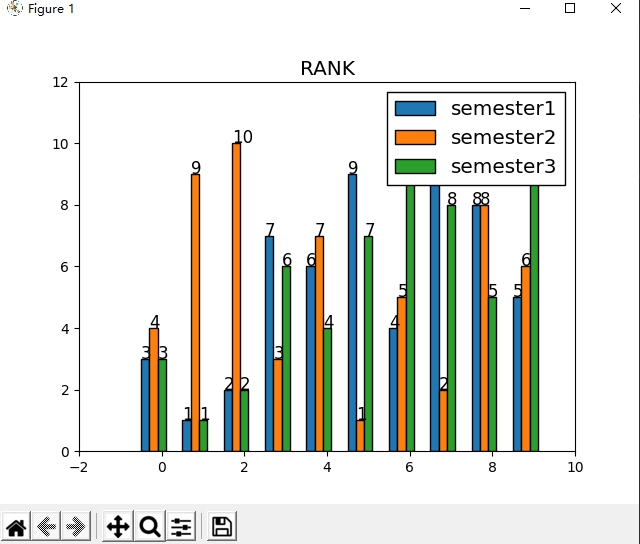
线图 :
把这个图像做一些调整,要求出现 5 个完整的波峰。
调大 cos 波形的幅度
调大 sin 波形的频率
import numpy as np
from matplotlib import pyplot as plt
x = np.linspace(-5 * np.pi, 5 * np.pi, 500)
y1 = 3 * np.cos(x)
y2 = np.sin(4*x)
fig, ax = plt.subplots()
plt.style.use('classic')
ax.spines["right"].set_visible(False)
ax.spines["top"].set_visible(False)
ax.spines['bottom'].set_position(('data',0))
ax.xaxis.set_ticks_position('bottom')
ax.spines['left'].set_position(('data',0))
ax.yaxis.set_ticks_position('left')
plt.plot(x, y1, color='blue', linestyle='-', label='y=3cosx')
plt.plot(x, y2, color='red', linestyle='-', label='y=sin3x')
plt.legend()
plt.show()
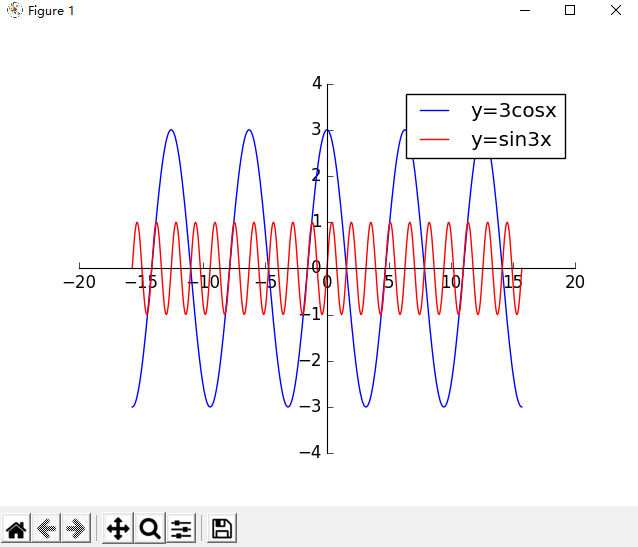
用线图展示北京空气质量数据
展示 10-15 年 PM 指数月平均数据的变化情况,一幅图中有 6 条曲线,每年 1 条曲线。
import numpy as np
import pandas as pd
from matplotlib import pyplot as plt
orig_df = pd.read_csv("./BeijingPM20100101_20151231.csv", encoding='utf-8', dtype=str)
orig_df = pd.DataFrame(orig_df, columns=['year', 'month', 'PM_US Post'])
df = orig_df.dropna(0, how='any')
df['month'] = df['month'].astype(int)
df['year'] = df['year'].astype(int)
df['PM_US Post'] = df['PM_US Post'].astype(int)
df.reset_index(drop=True, inplace=True)
num = len(df)
section = np.arange(1, 13)
record = 0
fig, ax = plt.subplots()
plt.style.use('classic')
plt.title("2010-2015 Beijing average PM2.5(from PM_US Post) per month")
for nowyear in range(2010, 2016):
i = record
result = [0 for i in range(13)]
nowsum = 0
cntday = 0
nowmonth = 1
while i < num:
if df['month'][i] == nowmonth:
cntday = cntday + 1
nowsum = nowsum + df['PM_US Post'][i]
else:
if df['year'][i] != nowyear:
record = i
result[nowmonth] = nowsum / cntday
break
result[nowmonth] = nowsum / cntday
cntday = 1
nowsum = df['PM_US Post'][i]
nowmonth = df['month'][i]
i = i + 1
result = result[1:]
#
x = np.array(range(1, 13))
plt.plot(x, result, linestyle='-', label=str(nowyear))
plt.legend()
plt.show()
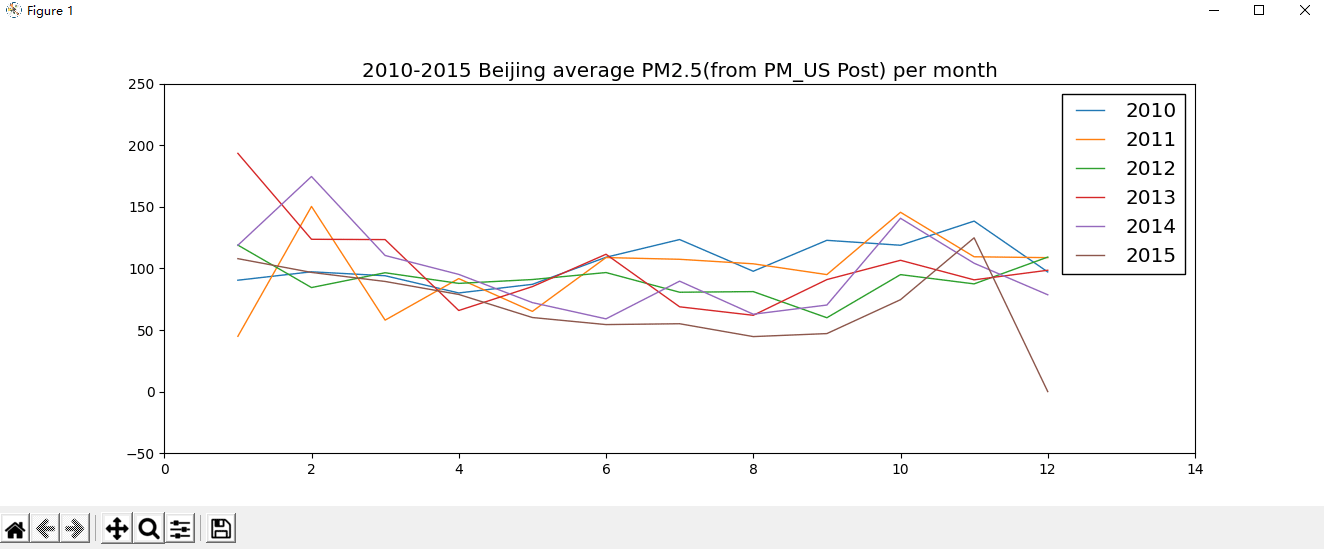
到此这篇关于Python实现数据可视化案例分析的文章就介绍到这了,更多相关Python数据可视化内容请搜索软件开发网以前的文章或继续浏览下面的相关文章希望大家以后多多支持软件开发网!